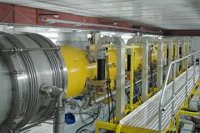 |
 |
|||||||||||||
|
|||||||||||||
|
|||||||||||||
|
A cryomodule prototype for the European XFEL has set the world gradient record for cryomodules built with superconducting radiofrequency technology, reaching an average accelerating gradient of more than 32 megavolts per metre (MV/m) in recent tests. This is an important step towards major goals set for the ILC’s Technical Design Phase (TDP), which include demonstrating system performance of fully fitted cryomodules like the record prototype. The accelerator module will be built into the FLASH free-electron laser at DESY, making it possible to increase the FLASH energy to 1.2 GeV. This means that even shorter wavelengths down to 4.5 nanometers will be available for experiments starting next year. The desired accelerating gradient of the module was specified to be 25 MV/m, which it passed easily. The accelerator module is a prototype for the European XFEL and its outer vacuum vessel as well as its cryogenic components, the so-called cold mass, were manufactured in China on behalf of the IHEP institute in Beijing. Later on, China will supply part of the cryogenic modules needed for the XFEL as a contribution in kind. In parallel to testing the manufacturing process of this module, called PXFEL1, the DESY team was able to crosscheck last small technical changes needed for the European XFEL. For this reason, the accelerating unit, the so-called cavity string, was adapted to the XFEL module design and mounted into the first cryomodule prototype from China. The prototype PXFEL1 was assembled at DESY from April to June 2009, with the participation of the CEA Saclay where cryomodules for the free-electron laser will be assembled in series in the future. Then it was directly installed into DESY's cryomodule test bench (CMTB) and cooled down to -271°C. After successful tests of the RF couplers, an average gradient of 32.5 MV/m was reached. At PXFEL1, all individual cavities reached the gradients that were expected on the basis of the previous results from the individual cavity test bench tests. The module also passed tests for heat losses, and the mechanical behaviour at cooling down from room temperature to -271°C showed that the observed shrinkage and movements of the whole structure are all within the allowed tolerances. PXFEL1 is a collaboration of the institutes IHEP/Beijing, CEA-IRFU/Saclay, IN2P3-LAL/Orsay, INFN/Milano, CIEMAT/Madrid and DESY within the framework of the XFEL. -- Barbara Warmbein |
|||||||||||||
| © International Linear Collider |
